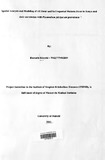| dc.contributor.author | Kinyoki, Damaris | |
| dc.date.accessioned | 2016-05-14T12:23:06Z | |
| dc.date.available | 2016-05-14T12:23:06Z | |
| dc.date.issued | 2011 | |
| dc.identifier.uri | http://hdl.handle.net/11295/95612 | |
| dc.description.abstract | Introduction: Fever has been used as the presumptive marker for malaria in Kenya for a long
time. The Kenya National Malaria Strategy 2001-2010 states that all fevers should be treated as
early and as close to a patient’s home as possible, with acceptable quality and correct dosages of
the first line anti-malarial and supportive treatment. The aetiology of fevers in malaria endemic
areas has been the subject of considerable basic and applied public health research for many
years. Plasmodium parasite is not the only cause of fever and only one of many pathogens that
cause identical pyrogenic responses in Kenya. Although fever usually has a high sensitivity for
the diagnosis of malaria it suffers from poor specificity and critically depends on the prevalence
of both asymptomatic infection and the overall prevalence of fever
Objectives: The overall objective of this study was to model the risk of self-reported fever in
Kenya and self-reported malaria and examine its relationship with the modeled estimates of P.
falciparum parasite prevalence.
Methodology: This was a cross-sectional study that sought to model the risk of all self-reported
reported fevers and self-reported malaria fevers in Kenya at district level against selected
covariates for the study and their relationship with actual risk of malaria infection. Household
level data assembled during the Kenya Integrated Household Budget Survey of 2005/06 was
used. Data were aggregated at the districts level. Semi-parametric regression models which
allowed joint analysis of nonlinear effects of some covariates, spatially structured variation,
unstructured heterogeneity, and other fixed covariates were developed. Modeling and inference
used fully Bayesian approach via Markov Chain Monte Carlo (MCMC) simulation techniques.
Results: The risk of all fevers and self-reported fever increases with increase in distance to the
health facility, parasite prevalence, proportion of people with no toilets and under-fives. The
ix
results also indicate that the risk of fever decreases with increase in the proportion of Male, the
proportion of the people using protected sources of water. The results also indicate significant
differences in both structured and unstructured spatial effects.
Conclusion: This study emphasizes that the methodological framework used provides a useful
tool for analyzing the data at hand and of similar structure. | en_US |
| dc.language.iso | en | en_US |
| dc.publisher | University of Nairobi | en_US |
| dc.rights | Attribution-NonCommercial-NoDerivs 3.0 United States | * |
| dc.rights.uri | http://creativecommons.org/licenses/by-nc-nd/3.0/us/ | * |
| dc.title | Spatial Analysis and Modeling of All Fever and Self-reported Malaria Fever in Kenya and their correlation with Plasmodium falciparum prevalence | en_US |
| dc.type | Thesis | en_US |
| dc.description.department | a
Department of Psychiatry, University of Nairobi, ; bDepartment of Mental Health, School of Medicine,
Moi University, Eldoret, Kenya | |



